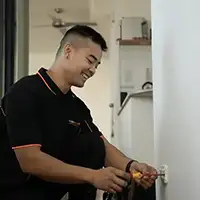Many Australian homes still contain outdated electrical systems that may pose serious safety risks. If you’ve noticed flickering lights, tripping switches, or unusual smells, your wiring could be due for an upgrade. This guide by Powerhub Electrical explains how to tell if your house needs rewiring, the risks of ignoring warning signs, and what’s involved in the process, including when to call a licensed electrician.
What Is House Rewiring?
House rewiring is the process of replacing old, unsafe, or non-compliant electrical wiring throughout a home. It’s not just about installing new cables, it includes upgrading sockets, switches, and the main switchboard, and ensuring everything complies with the current electrical standard, AS/NZS 3000. Rewiring must legally be done by a licensed electrician in Australia and often involves both wall and ceiling access.
What’s Involved in a Full Rewire
- Removal of outdated or damaged wiring
- Installation of new cables, switches, and socket outlets
- Upgrade of the switchboard with modern circuit protection
- Installation of RCDs (safety switches) and circuit breakers
- Final testing to ensure safety and compliance
- Issuing of a Certificate of Electrical Safety
Why Rewiring Is Important
- Reduces the risk of electrical fires caused by degraded insulation or loose connections
- Protects residents from electric shocks or faults in un-earthed systems
- Ensures the home can safely handle modern appliance loads
- Brings the property up to today’s legal and safety standards

Signs That Your House May Need Rewiring
Not all faults are hidden behind walls, many signs are visible or noticeable in daily use. Here’s what to watch for:
- Tripping safety switches, especially when plugging in appliances
- Lights flickering or dimming unpredictably
- Buzzing or crackling sounds from power points or switches
- Warm sockets or a burning smell near outlets
- Discoloured or cracked faceplates on switches or sockets
- Two-prong outlets or a lack of visible safety switches in the switchboard
- Older fittings such as round light switches or surface-mounted wiring in older homes
These are common signs of faulty wiring or outdated electrical infrastructure and should not be ignored.
When Was Your House Last Rewired?
If you don’t know when your home was last rewired, it’s worth checking, especially if it’s more than 30 years old. Electrical systems degrade over time, and many homes built before the 1990s may no longer meet current standards.
Wiring Materials by Era (General Guide)
- Pre-1960s: Often used VIR (Vulcanised Indian Rubber) or cloth-sheathed wiring, which is now unsafe
- 1960s–70s: Early PVC wiring, sometimes without earthing
- 1980s–90s: More reliable, but may not include safety switches
- Post-2000s: Usually compliant but should still be inspected every 10 years for wear or changes

Has the Switchboard Been Updated?
An outdated switchboard is a strong indicator that the house may need rewiring. Visual signs include:
- Ceramic fuses or exposed wire links
- Lack of RCDs (safety switches)
- No labelling or general disorganisation
A modern switchboard should include RCD protection for all final subcircuits and labelled circuit breakers.
Safety Risks of Old or Damaged Wiring
Old wiring can be dangerous. Some risks include:
- Fire hazards from degraded insulation or exposed conductors
- Shock risk due to lack of earthing or exposed terminals
- Overloaded circuits unable to handle modern devices
- Potential legal issues if selling or renting the property without meeting safety standards
Important: All inspections, repairs, and rewiring must be carried out by a licensed electrician. DIY wiring work is illegal and unsafe.

What to Expect During a House Rewire
A full rewire can sound daunting, but with proper planning it can be done efficiently and safely. Here’s how the process typically works:
Inspection and Planning
- A licensed electrician inspects the existing wiring and identifies faults
- A written quote is provided outlining the scope of work
- Work is scheduled with a plan to minimise disruption
Rewiring Work
- Access points are created in walls or ceilings to remove and replace wiring
- New sockets, light fittings, and switchgear are installed
- A new switchboard is fitted with RCDs and labelled circuits
Final Testing and Certification
- All circuits are tested for safety and compliance with AS/NZS 3000
- A Certificate of Electrical Safety is issued
- The home is ready for normal use with safe, modern wiring
When to Call an Electrician
You must use a licensed electrician for any wiring work in Australia, DIY is not allowed by law. Call an electrician immediately if:
- You notice a burning smell from sockets or switches
- A switch sparks, feels hot, or makes cracking sounds
- A circuit breaker repeatedly trips and won’t reset
- You are unsure about the age or condition of your home’s wiring
Powerhub Electrical provides inspections and 24/7 callouts in Sydney and can assist with identifying faults and planning rewiring work.
Preventive Electrical Maintenance Tips
To reduce the risk of future wiring issues, consider the following:
- Have your wiring and switchboard professionally checked every 5–10 years
- Avoid using too many appliances on a single power board
- Always follow the manufacturer’s guidelines when using devices
- Ensure outdoor power points and lights are properly weatherproofed
- Don’t ignore minor issues like flickering lights or switches that feel hot

Need Help Checking Your Home’s Wiring?
Only a licensed electrician can safely assess whether your home’s wiring meets modern safety standards. If you’re unsure about your switchboard, experiencing power issues, or living in an older property, it’s best to book an inspection. Powerhub Electrical offers free safety checks and no-obligation quotes for homeowners in Sydney.
Frequently Asked Questions
How often should a house be rewired?
Most homes should be rewired every 30 to 40 years, depending on the condition of the materials and whether the electrical system meets modern standards. However, switchboards and safety devices should be checked every 10 years. If your home is over 25 years old and hasn’t had an upgrade, an inspection is recommended.
Can I check if my wiring is old myself?
You can look for surface signs such as old-style sockets, cracked fittings, or exposed wire casing. You might also check your switchboard for ceramic fuses or the absence of RCDs. However, only a licensed electrician can legally open walls or test circuits to confirm the age and safety of wiring.
What does a house rewire cost in QLD?
Costs vary based on the size of the home, access to walls and ceilings, and whether a switchboard upgrade is included. As a general guide, a full rewire for a standard three-bedroom house may cost between $5,000 and $15,000. It’s best to get a detailed quote from a licensed electrician based on your property.
Is rewiring covered by insurance?
Most home insurance policies do not cover the cost of rewiring as it’s considered a maintenance task. However, damage caused by faulty wiring (such as a fire) may be covered. Some insurers may also require a wiring inspection or upgrade as a condition for coverage in older homes.





